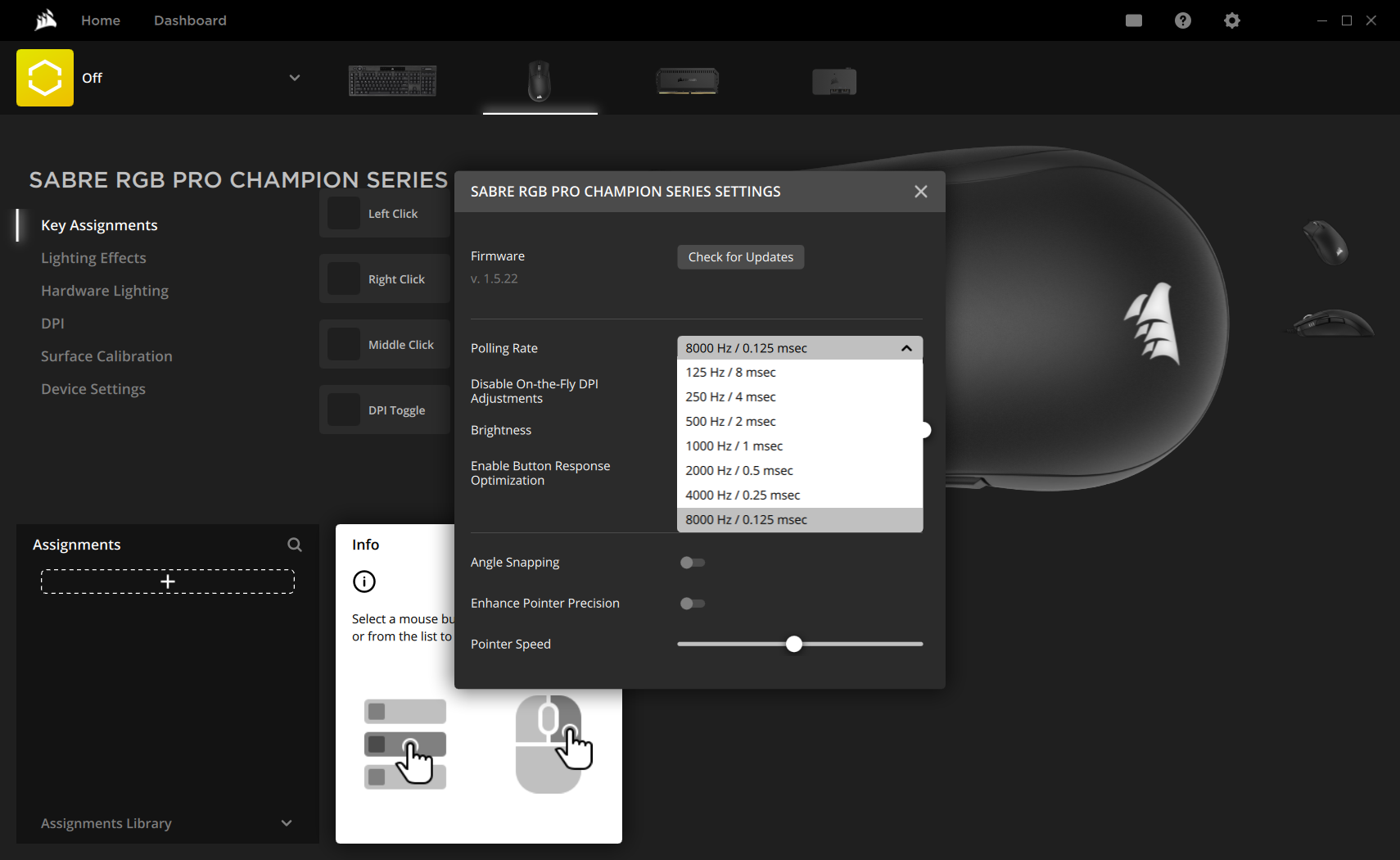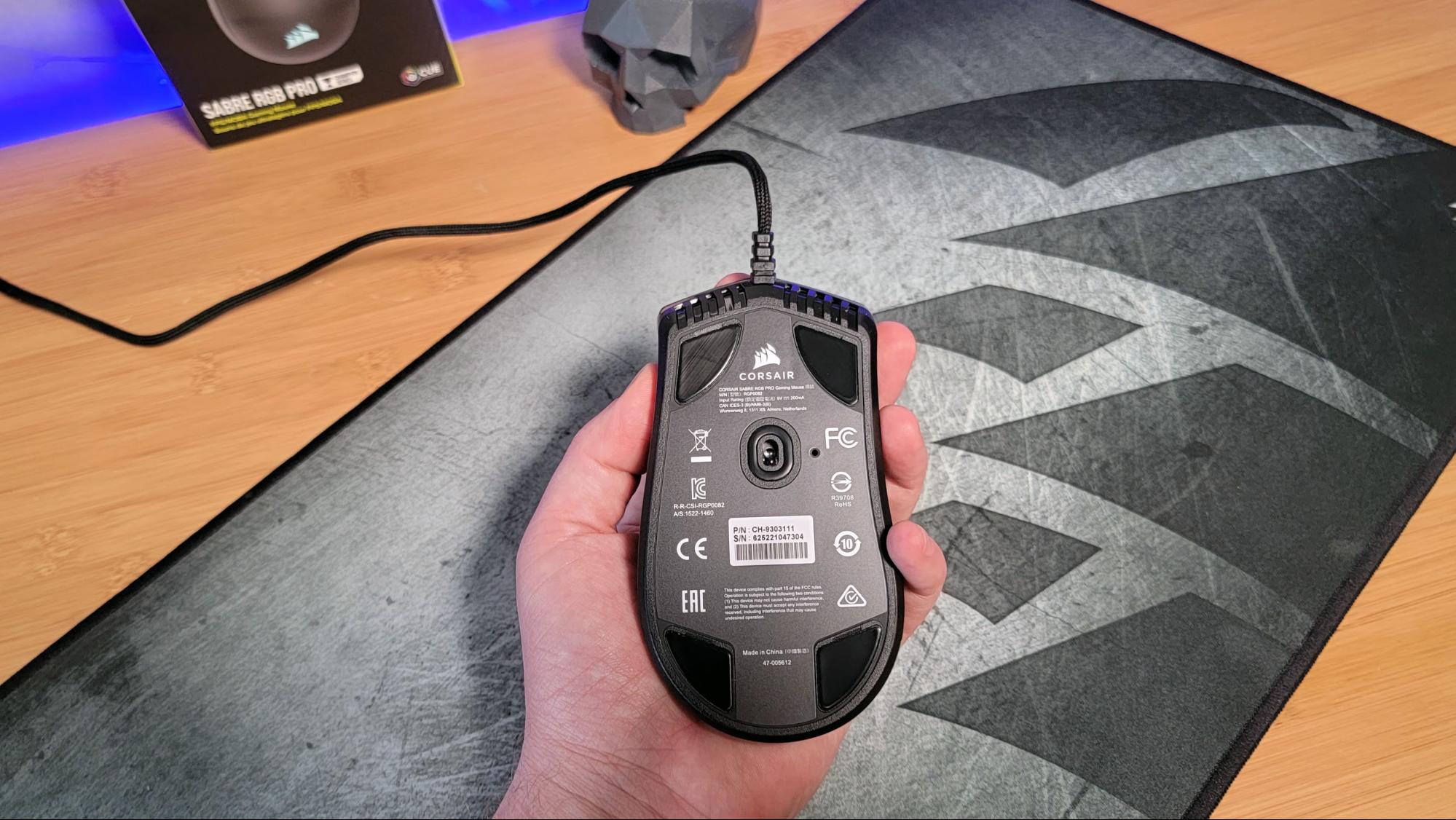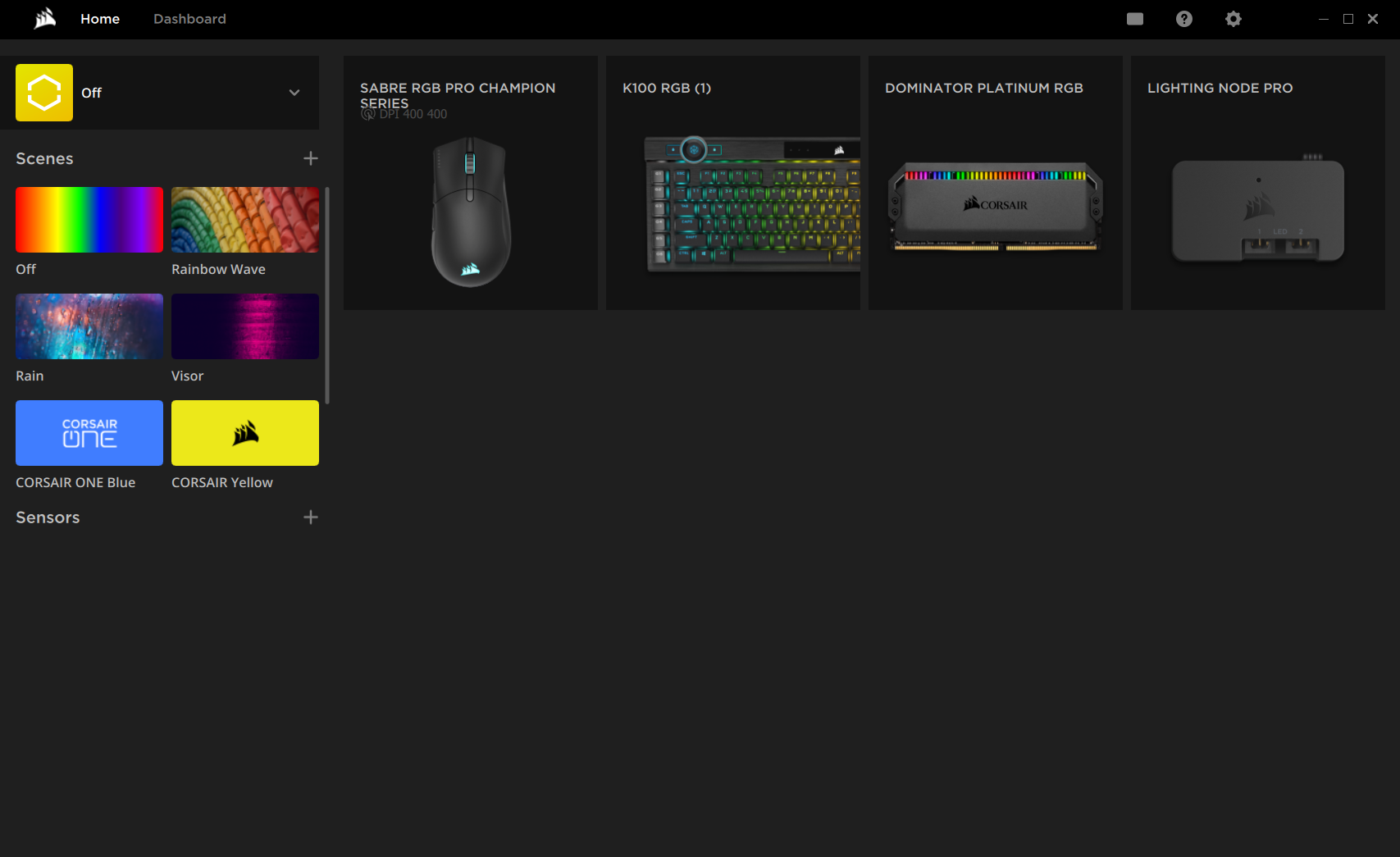Tom's Hardware Verdict
Corsair joins Razer in the 8,000 Hz mouse club with the Sabre RGB Pro. Solid, speedy specs and improved iCue software make it a good mouse, especially for the price. However, to make use of its key features without sacrificing gaming performance, you probably need to upgrade your CPU.
Pros
- +
+ Selectable polling rate up to 8,000 Hz
- +
+ Spring-loaded buttons/mechanical switch combo feels fast and durable
- +
+ Corsair iCue software gets a needed overhaul
- +
+ Reasonable price
Cons
- -
8,000 Hz polling makes for demanding CPU/USB requirements
- -
Not ambidextrous like competing Razer model
Why you can trust Tom's Hardware
In an ongoing effort to craft the best gaming mouse, peripheral makers used to battle over the DPI/CPI sensor specs. Then, the focus shifted to achieving the lightest possible weight. Now, the cutting edge seems to be moving to polling rate, the number of times per second your gaming rodent sends data back to your PC. First, we saw Razer’s Viper 8K Hz, which jumped up from the usual 1,000 Hz polling rate. And now Corsair is joining the 8,000 Hz rat race with the Sabre RGB Pro.
Along with its ultra-fast communication abilities, it sports a solid 18,000 DPI custom Pixart sensor, quality Omron-brand mechanical switches and spring-loaded buttons to help assure the input from your fingers and wrist travels through the mouse and back to your PC for the quickest response time possible. It’s a well-crafted mouse for MOBA/FPS eSports gamers, especially those who prefer a palm grip. And at an MSRP of $59.99, it’s more affordable than Razer’s $80 8,000 Hz alternative.
But as with Razer’s mouse, the primary concern here if you’re looking to get the full benefit of the 8K polling ability is that you may need to upgrade your rig. You can dial back the polling rate to 4,000, 2,000, 1,000 Hz or even lower via the company’s recently revamped iCue 4 software. But at top speed, you’re effectively sending 8 times the amount of data to your gaming rig compared to a more traditional rodent.
Corsair says your system should sport a Intel Core i7 9th Gen or AMD Ryzen 7 2nd Gen CPU or higher to use the Sabre RGB Pro at full clip. And they aren’t kidding. In some anecdotal testing using my custom-built Ryzen 5 2600X system, I saw CPU use spike 10-16% or more when just moving my cursor around quickly at the desktop. That lessened to about 6-10% when doing the same thing on a more recent Ryzen 7 3700X machine. If you already have a recent high-end processor, that’s reasonable. But if not, are you ready to upgrade to one of the best CPUs to ride the wave of cutting-edge mouse technology?
Corsair Sabre RGB Pro Specs
| Sensor Model | PixArt PMW3392 | Row 0 - Cell 2 |
| Sensitivity | 100-18,000 DPI | Row 1 - Cell 2 |
| Polling Rate | 125/250/500/1,000/2,000/4,000/8,000 Hz | Row 2 - Cell 2 |
| Programmable Buttons | 4 | Row 3 - Cell 2 |
| LED Zones | 2x RGB | Row 4 - Cell 2 |
| Connectivity | USB Type-A | Row 5 - Cell 2 |
| Cable | 82 inches (2.08m), paracord | Row 6 - Cell 2 |
| Measurements (LxWxH) | 5.1 x 2.76 x 1.7 inches (129 x 70 x 43mm) | Row 7 - Cell 2 |
| Weight | 2.61 ounces (74g) | Row 8 - Cell 2 |
8,000 Hz Polling Rate: You Probably Aren’t Ready
A polling rate is how many times a second your mouse (or other peripheral) sends data back to your PC. A 1,000 Hz polling rate for gaming mice has generally been thought of as sufficient for most gamers for years (with many happy to drop down to 500 Hz). But with the best gaming monitors leapfrogging past the old standard of 60 Hz, all the way up to 360 Hz (and, perhaps, beyond that soon), it logical that you’d want your peripherals to input data at a faster pace to keep up with faster hardware and increasing frame rates.
The Sabre RGB Pro brings 8,000 Hz polling to the table -- or, more aptly, the gaming desk -- although as noted earlier, Razer got here first with the Viper 8K. However, at $80, the Razer mouse costs $20 more than Corsair’s Sabre RGB Pro. And Corsair did start down the road of high-polling peripherals last year with the Corsair K100 RGB keyboard, with its 4,000 Hz polling rate.
So the obvious question is: Does 8,000 Hz polling make a difference in gaming? That’s a tough question to answer personally, given that I’m in my mid-40s and don’t have the same reflexes I did in my teens and early 20s. But it’s probably safe to say that, for a certain subset of competitive gamers (Corsair markets the Sabre to competitive FPS and MOBA players), having a mouse that sends data at 8,000 Hz, rather than 1,000 Hz, will result in better performance. But much like with gear designed for/by elite athletes (and marketed toward the general consumer), the gains are likely to be small for most and much more important to those pushing the edge of physical performance than the average consumer/gamer who just wants to have some fun after work.
The larger issue, arguably, comes down to recommended specs. Because while eSports is undoubtedly a huge global phenomenon, the games generally aren’t all that demanding. So eSports hardware often isn’t as high-end as the enthusiast rigs you’ll find running cutting-edge AAA titles at 4K resolution with all the eye candy set to high.
Most gamers probably don’t generally check to see if their CPU can handle their new mouse. However, in order to reap the benefits of the 8,000 Hz mouse, Corsair recommends you have at least an Intel Core i7 9th Gen or AMD Ryzen 7 2nd Gen CPU. But a newer CPU, as well as a discrete or, better yet, high-end graphics card and screen with a high refresh rate will help make in-game benefits more apparent. Corsair also says you should use a native USB port (that is, not one connected to a hub or a third-party chipset on the board) because sending your mouse movement and button data back to your PC at 8 times the normal rate is much more taxing on your hardware.
To investigate this, I first connected the Sabre RGB Pro to my living room rig, which is a bit dated and houses a Ryzen 5 2600X CPU. This is lower than Corsair’s recommendation, but it’s still a CPU that’s plenty capable of running modern games at fairly high settings.
Glancing at the Performance tab of Task Manager with the mouse plugged in and switched to 8,000 Hz mode, CPU utilization jumped from around 6% to about 16-22% and sometimes higher when just moving the mouse quickly at the desktop. When combined with hitting keys quickly on the company’s 4,000 Hz K100 keyboard, as you would during an intense gaming battle, CPU utilization seemed to jump up even more. Keep in mind that I wasn’t running a game, just my typical workflow, (which to be fair, is too many browser tabs, plus leaving Photoshop open with a few images I was editing). The mouse won’t use more CPU when gaming, but the game you’re running certainly will, giving you fewer spare cycles for your high-polling peripherals to work with.
Again, the Ryzen 5 is below Corsair’s recommended specs for this mouse. But there’s no mention of this recommendation on the box, just in the reviewer’s guide. That said, the 8,000 Hz feature isn’t called out on the box either. And the company seems to know most buyers aren’t going to be ready for this level of performance, as the mouse shipped to me in 1,000 Hz mode. I had to download the new version of the company’s iCue software (more on that later) to switch the mouse to its fastest polling rate.
So while the 8,000 Hz feature may be helpful for some elite gamers with high-end rigs, it’s not a feature to jump at yet unless you already have a high-end CPU or tend to keep your gaming peripherals for several years and are looking for a bit of future-proofing.
And if you’re an eSports professional, unless you have a powerful rig with a recent high-end CPU, be prepared to turn the polling down. There are at least several selectable polling speeds, so you should be able to dial in the rate that feels right and works best for your hardware.
Design of Corsair Sabre RGB Pro



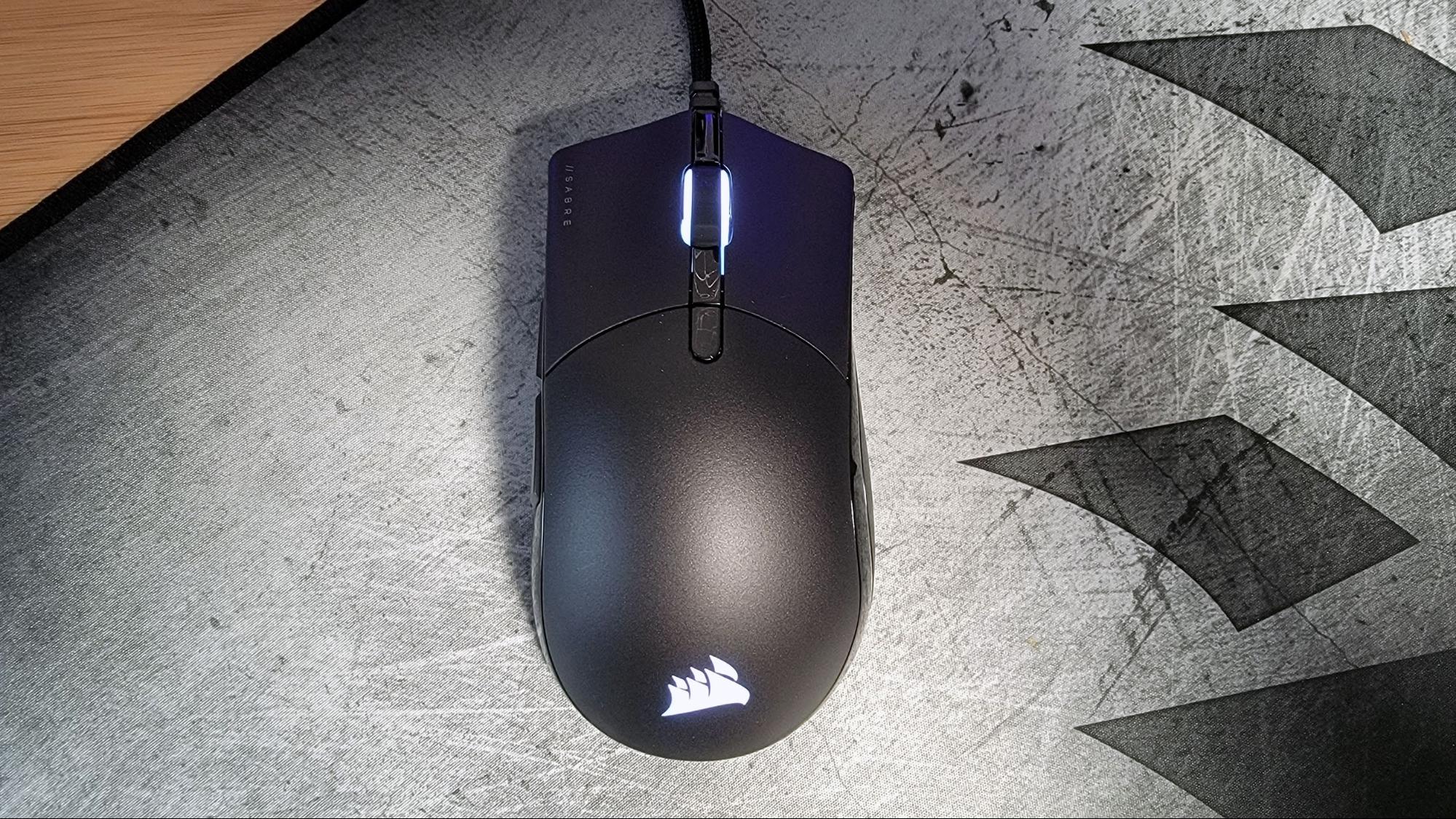
The Sabre RGB Pro’s high polling abilities aside, it’s also a capable rodent for other reasons. Corsair equipped it with a custom PixArt PMW3392 sensor that lets you dial in the DPI sensitivity anywhere from 100 to 18,000. You also get Omron switches, rated for 50 million clicks, and spring-loaded main mouse buttons (Corsair calls them QuickStrike) so there’s no gap between the button and the switch for the fastest possible response -- a feature that pairs well with the fast polling rate.
Get Tom's Hardware's best news and in-depth reviews, straight to your inbox.
The general design of the mouse is pretty standard, which I find a good thing for the sake of comfort and familiarity. Aside from the main buttons and the ratcheting RGB scroll wheel, you get a DPI button on the top (behind the wheel), and a three-light DPI indicator on the left side. Also on the left are the two additional buttons, which are made of the same matte plastic as most of the rest of the mouse and are the right size and in the right place for easy use.
That said, the Sabre RGB Pro isn’t ambidextrous, unlike Razer’s competing 8K Viper. But the Viper is flatter with less of a bulge at the back, (where you’ll find the second RGB zone on the Sabre), making it a poor choice for palm grips. As I lean toward palm (or, more accurately, I switch between fingertip and palm, depending on what I’m doing), I find Corsair’s design more comfortable. But your mileage may vary, especially if you’re left-handed.
The bottom of the Sabre RGB Pro is adorned with four fairly-substantial PTFE feet which, combined with the fairly light 2.65 ounce (75g) weight, makes it easy to move, whether you’re making minute adjustments through a sniper scope or flailing around wildly trying to avoid impending death.
You also get a paracord-covered anti-snag gable that, at about 82 inches (208.28cm), is at least long enough to easily reach back behind your system to a native USB port.
Features and Software of Corsair Sabre RGB Pro
Corsair’s iCue software, while in some ways more powerful and polished than some of the peripheral competition, has also become increasingly unstable in recent months (both for myself and at least one colleague). But right around the time I started using the Sabre RGB Pro, the company launched version 4 of iCue, which looks and feels more modern and fresh, and seems (for me at least) to have vastly reduced the program’s tendency to crash.
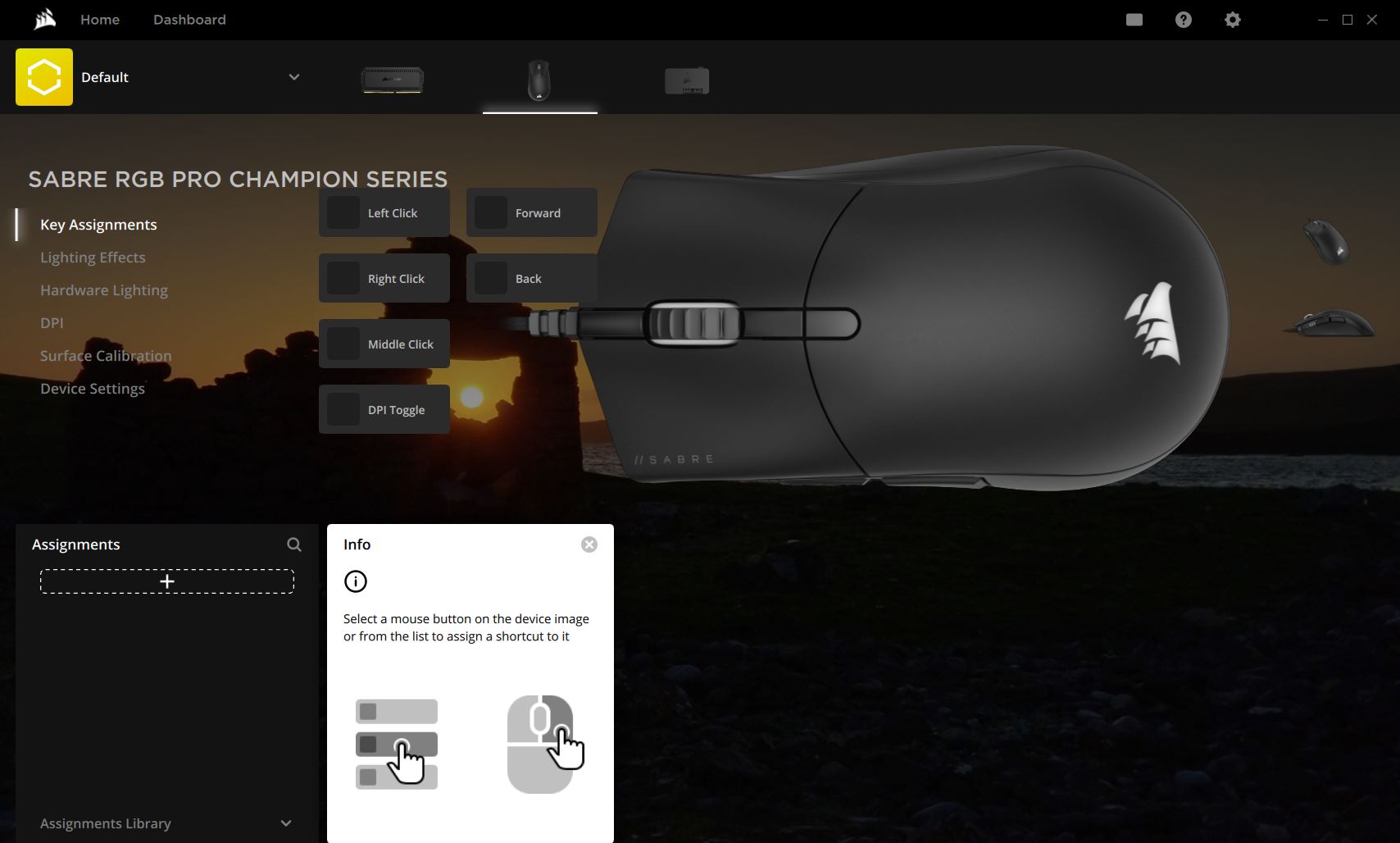
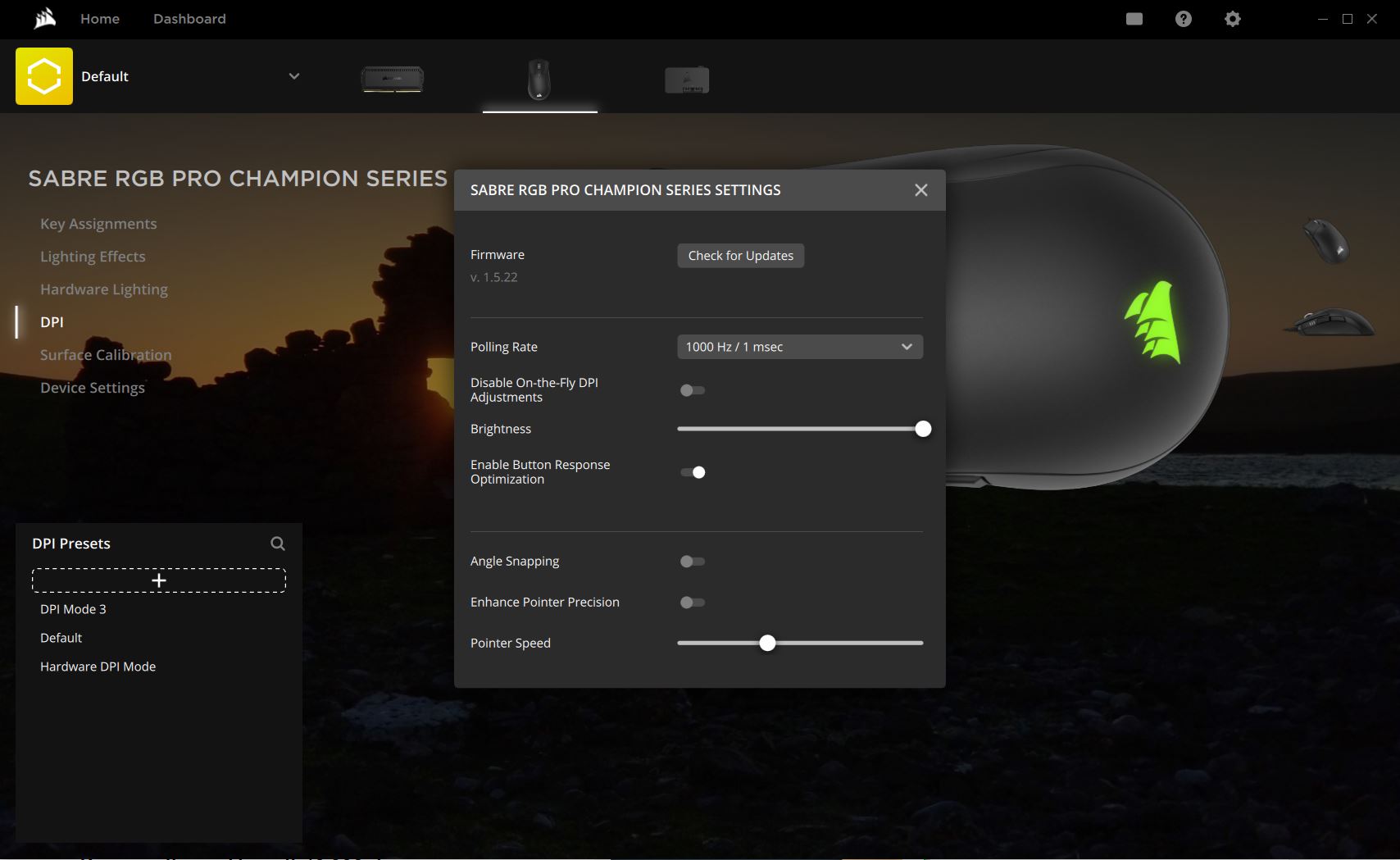


As for software settings for the Sabre RGB Pro specifically, there are dropdowns for DPI, button assignment, lighting, surface calibration and a device settings section that’s a catch-all for everything else. There, you can check for firmware updates, brightness controls for the two RGB zones, a pointer speed slider and a couple of switches to enable or disable angle snapping, enhanced pointer precision and optimization of button response. It’s unclear why you’d want your button response not to be optimized, but I didn’t notice a difference either way.
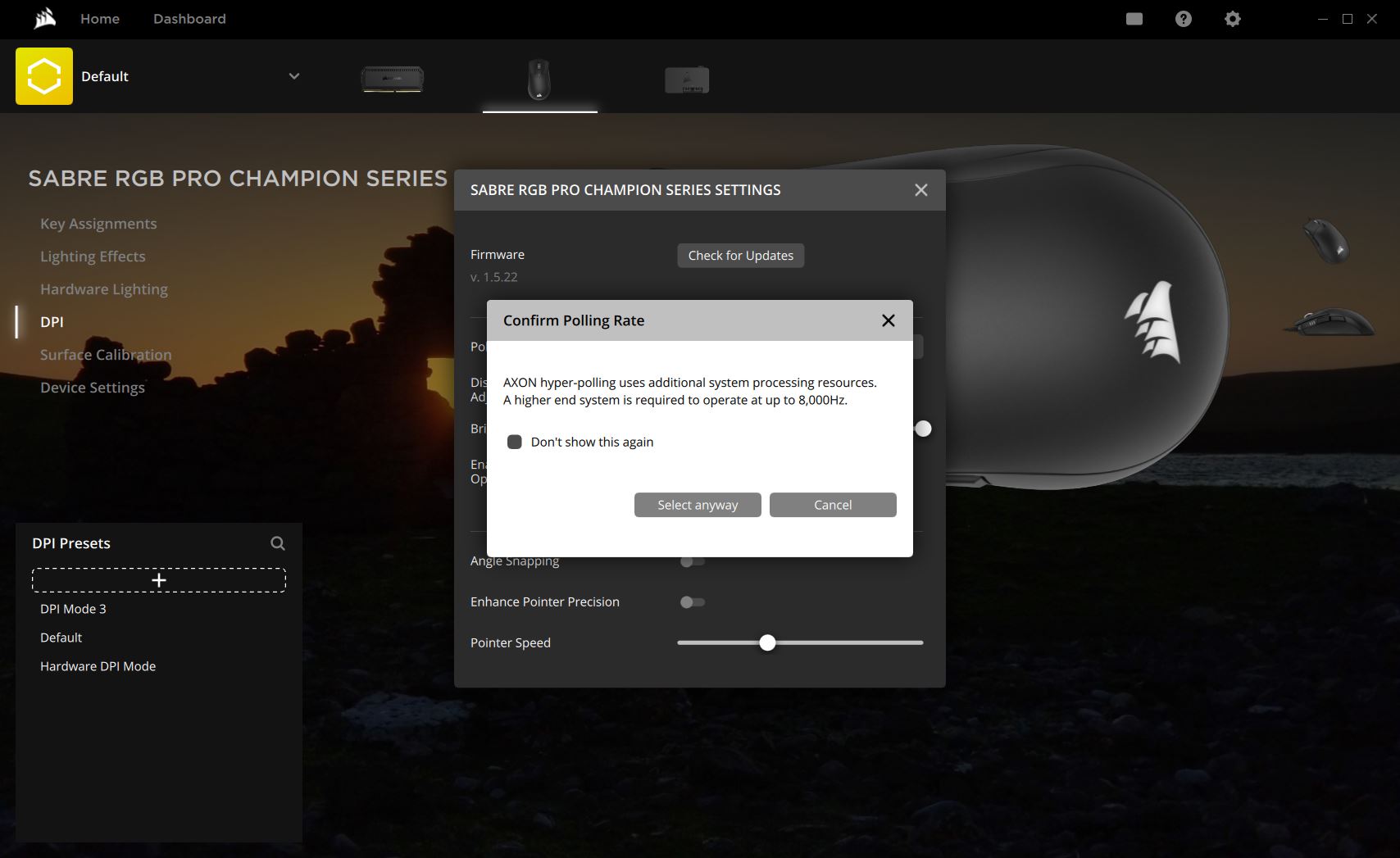
This is also where you’ll find the menu to select the polling rate. There are seven options between 125 Hz and 8,000 Hz. Changing this setting results in the mouse audibly disconnecting from your system and then reconnecting at the changed rate about 1 second later. And in a nod to how demanding the 8,000 Hz setting can be on your PC, the software gives you a popup warning whenever you enable the highest setting (or until you check the box to tell it to stop nagging you about it).
Overall, the software is an appreciated improvement over previous versions of iCue, and I didn’t find myself missing any selectable features I would have liked to see. In an ideal world, it would be nice to be able to change polling on the fly as you can with DPI, but that seems to be a hardware limitation, would likely cause issues in-games and, as I’ll detail more in the next section, aside from some of the lower settings, my mousing arm mostly couldn’t tell the difference between the different polling rates anyway.
Gaming Performance of Corsair Sabre RGB Pro
I put the Corsair Sabre RGB Pro to good use for hours in my current gaming gauntlet, which admittedly doesn’t include any MOBA titles, but does include some FPS shooters. Whether it was in RTS titles, like Ancestors Legacy and Iron Harvest, the sometimes disorienting space combat of Star Wars: Squadrons or frenetic fights in FPS games, like Doom Eternal and Borderlands 3, the Sabre RGB Pro was fast, comfortable and reliable.
The buttons felt good and were where my fingers expected them to be, and the sensor never let me down. That said, I can’t say I noticed a perceived difference whether I had the mouse set to 8,000 Hz or 1,000 Hz. However, my CPU was also a little less powerful than Corsair recommends.
I did feel the difference dropping down to 500 Hz, so my reflexes may just not be up to the level where fast polling makes a discernible difference. I’m certainly not an elite gamer by any stretch. If you are, perhaps 8,000 Hz polling will give you a bit of an edge.

Bottom Line
I wouldn’t buy this mouse or the competing Razer Viper 8K Hz just for the polling rate increase. That is, I wouldn’t unless I was truly a high-level competitive gamer and already had a high-refresh monitor and a recent, high-end CPU.
As to whether Corsair’s offering is better or worse than Razer’s Viper 8K, that depends on your grip style and whether or not you’re a left-handed gamer. If you are, the Viper wins for its ambidextrous design. But I prefer the slightly bulgier Corsair Sabre RGB Pro for its more comfortable palm grip and its left side buttons that are a bit bigger and more comfortable to click. Corsair’s model also costs $20 less, which makes it easier to argue for.
And that $59.99 price point also makes the Sabre Pro RGB easier to recommend in general, even if you don’t care about the high polling rate or you just want to have it available in the future once you’ve upgraded your CPU and monitor. With its 18K sensor, comfortable design and speedy, premium buttons, this is a very good gaming mouse, regardless of whether you’re ready for 8,000 Hz polling or not.
After a rough start with the Mattel Aquarius as a child, Matt built his first PC in the late 1990s and ventured into mild PC modding in the early 2000s. He’s spent the last 15 years covering emerging technology for Smithsonian, Popular Science, and Consumer Reports, while testing components and PCs for Computer Shopper, PCMag and Digital Trends.
-
mac_angel Heaven forbid you ever have to deal with Corsair for warranty though. I don't know if they are outsourcing their tech support or what, but they refused to honour the warranty of my quad channel RAM kit with the argument "dual channel is the same"Reply -
g-unit1111 Finally iCue gets a much needed overhaul. It's ridiculously frustrating in its' current form.Reply -
thepersonwithaface45 Reply
Oh? They updated it?? That could be an article in itself, just looked at the bottom portion of the article and it do be lookin pretty nice. Always had trouble confirming if my changes were saved or not.g-unit1111 said:Finally iCue gets a much needed overhaul. It's ridiculously frustrating in its' current form. -
g-unit1111 Replythepersonwithaface45 said:Oh? They updated it?? That could be an article in itself, just looked at the bottom portion of the article and it do be lookin pretty nice. Always had trouble confirming if my changes were saved or not.
Hopefully the new version is slightly less of a PITA. But it is annoying attempting to use forward / back functions on any Corsair mouse. I bought a Logitech G903 and it's worlds better than my Vengeance M65. -
Kamen Rider Blade Would pluging this mouse into a dedicated USB Controller Card lessen the CPU load?Reply -
Makaveli Replyg-unit1111 said:Hopefully the new version is slightly less of a PITA. But it is annoying attempting to use forward / back functions on any Corsair mouse. I bought a Logitech G903 and it's worlds better than my Vengeance M65.
I don't have any issues with forward and back with my corsair mouse. -
escksu Mouse 8000hz but monitor is 144hz (some models 200hz or more)... but not all game could hit 144 or 200fps...some can but not all.Reply
So regardless of how many times your mouse poll, its still limited by your fps and monitor refresh rate. its not to say that its useless, but diminishing returns. -
cryoburner An 8,000 Hz polling rate seems a bit excessive. Even at 1,000 Hz, your system will be reading the mouse's position roughly four times for every frame on a 240Hz display. I suppose that could mean up to 24% jitter from one frame to the next on such a high-refresh screen though, depending on whether the most recent update was immediately before the frame was rendered, or a quarter frame prior, which might make movement a little less smooth than it could be. At 2,000 Hz the maximum jitter would drop to 12%, or 6% at 4,000 Hz, and 3% at 8,000 Hz. We are only talking fractions of a millisecond though, on a frame that takes multiple milliseconds to be displayed, so I'm not convinced there would be a noticeable difference between something like 4,000 and 8,000 Hz. And that's assuming the OS is even polling the mouse at a perfect 8,000 Hz rate, which it might not be if other other things are interrupting it.Reply
The drivers still needs to read all the data about the mouse's position, button-presses and so on each time it is polled, then possibly process that data in some way before reporting it to the OS, which will in turn store the data in other locations in memory. There are probably a lot of inefficiencies along the way, especially since the standard USB polling rate is just 125 Hz, whereas this is 64 times that. If the OS and drivers were being smart about it, this might all be getting done on a dedicated core on processors with enough cores to spare, though that's probably not happening.Kamen Rider Blade said:Would pluging this mouse into a dedicated USB Controller Card lessen the CPU load? -
escksu ReplyKamen Rider Blade said:Would pluging this mouse into a dedicated USB Controller Card lessen the CPU load?
Nope. Because USB cards are simply just phy controllers on a card. No different from those soldered on your board.
I understand where you are coming from. A dedicated processor to offload task from the cpu (similar to server NIC and raid controllers). However, it may not be desirable as it will introduce additional latencies. -
Kamen Rider Blade Reply
I was just hoping for a dedicated USB Processor per USB port, that would allow each port to be a Root Port/Hub.escksu said:Nope. Because USB cards are simply just phy controllers on a card. No different from those soldered on your board.
I understand where you are coming from. A dedicated processor to offload task from the cpu (similar to server NIC and raid controllers). However, it may not be desirable as it will introduce additional latencies.
https://wiki.fractalaudio.com/wiki/index.php?title=CPU_usage
This way, no matter the polling rate, no matter how much data you send through the USB port, the impact on your CPU usage would be little to negligible.
